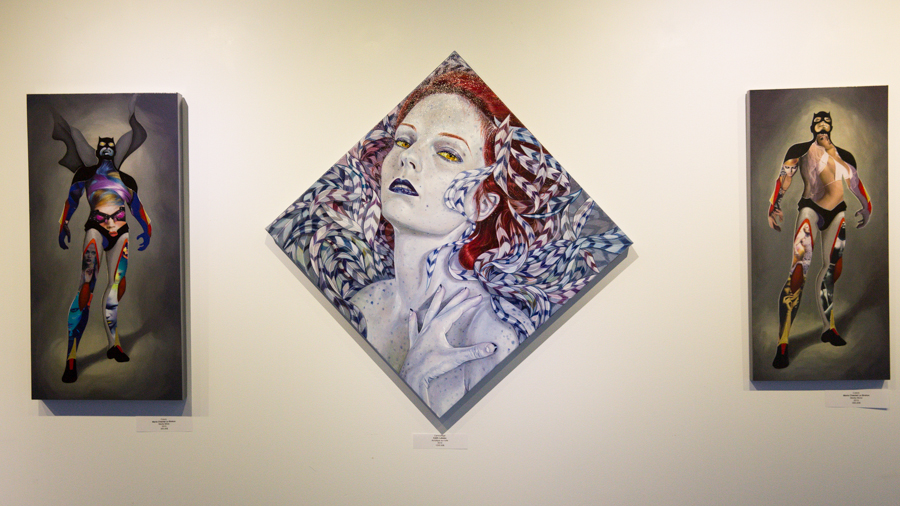While you can always expect to find some form of creativity in a tattoo parlour, Montreal’s Galerie Abyss takes the meaning of “tattoo art” to a whole other level. The tattoo shop doubles as an art gallery, inviting local artists to display their talents. Its newest exhibit, “Superheroes,” offers reinterpretations of popular comic book characters.
Abdala Kaufmann, owner of Galerie Abyss and host of the exhibit, has a degree in fine arts and has been tattooing for several years. She identifies her space as a vehicle, not only for showcasing her own abilities to tattoo, but also for promoting an “alternative” side of Montreal art, with the goal of becoming a “hotspot for Montreal artists.”
In “Superheroes,” Kaufmann remains true to this alternative, local mandate, featuring 21 Montreal-based artists, each given an equal amount of space, and thus equal value, in the exhibit. The diversity in artists creates an expansive range of styles and treatments of the superhero theme. The pieces vary from seemingly straightforward and typical portraits – such as a large Catwoman piece and another Venom portrait – to more serious and sombre black and grey pieces.
The exhibit also offers satirical and even subversive representations of the familiar characters, best exemplified by a series of portraits which depict famous superheroes indulging in sexual acts (such as the Ninja Turtles seducing April O’Neil). The series subverts the typical conception of superheroes and their conventional heroic personae by exposing the characters as less than pristine. Though this was an interesting spin on the classical superhero, there were perhaps a few too many of these sexualized pieces.
In addition to depicting aspects of superheroes that often escape the spotlight, like their sexuality, many pieces took on the task of reinventing what it means to be a superhero. Some pieces put a contemporary spin on the classic comic book theme, expanding the traditional superhero canon by choosing Disney’s Darkwing Duck, or a broad landscape from the contemporary animated show Adventure Time. This reinvention used humour more often than not, such as the depiction of Robocop (who is shown to be stealing Shrödinger’s cat, proclaiming he is taking the cat “dead or alive”) painted by David Merk. Merk, an American-born, Nova Scotia-raised artist, explained that his “witty” style is made possible by alternative, open-ended exhibits such as “Superheroes,” which allowed him to take a humorous spin on Robocop.
Other artists in the exhibit riff on the superhero trope by removing the heroic imagery from heroic personae, such as in a small-painted series of pieces depicting Captain America, Nightcrawler, and Ghost Rider as miniaturized and heavily obese, and another depicting Joker and Batman as children on a bench eating potato chips (Batman munches on salt and vinegar while Joker opts for ketchup).
Instead of celebrating the hero, these pieces examine superheroes by taking away their key features: strength and public personae. Melsa Montagne does this in a striking (and very Hitchcockian) manner by depicting Catwoman as she turns into a bird. Montagne uses her abstract style to tell the story of a strong character being turned into something she does not want to become, mocking the characters in this exhibit in a serious manner.
Montagne agreed with Merk that this exhibit was different in the sense that she had the freedom to produce something she didn’t necessarily know a lot about, saying, “I had to do a lot of research […] because I’m not a superfan of superheroes.” Many of the artists in this exhibit are not particularly specialized in comics and comic book heroes, but that is what gives the exhibit its relevance. These artists that come from highly different backgrounds in training and style combine their individuality with an average popular knowledge of superheroes, taking these common icons and giving them new meaning.
In a similar vein of removing key character traits, Marie Chantal Le Breton’s piece features a Batman-esque silhouette but with sexualized women inhabiting its empty spaces, homage to a rising artist who makes collages of superhero comics and feminized figures. Le Breton’s piece takes away the hypermasculinity of the male silhouette and replaces it with a feminine aura instead. Again, the artist reshapes the commonly accepted viewpoints, whether humourously (like Merk) or with more of a message-driven and abstract style (as with Montagne and Le Breton).
While the exhibit certainly showcases a great deal of superheroes and does so very diversely, those looking for traditional comic book art might be disappointed with the gallery’s open-ended and artist-motivated approach to these characters. This seems to be the all-encompassing idea of both Galerie Abyss’s ideology and this exhibit specifically.
The point is not so much whether the superheroes are mocked or depicted as idealized figures, but rather that they are placed within the hands of the artists who paint or sculpt them, completely on their own terms.
The approaches to the theme are so varied that they do not showcase superheroes as a theme per se, but rather showcase the artists who, through their own interpretation, undermine and rewrite the superhero stereotypes.
This expansion on the superhero is a welcome addition, and a necessary one too if comic books and other superhero mediums are to be kept as participatory culture. Thus, as Le Breton puts it, these thematic events allow for one to differentiate the “artist from the artisan,” the latter of whom would fall into some kind of predetermined, day-to-day routine in terms of creative production. The exhibit allows for both character and artist to embrace the presence of the brush and reveal their hidden alter-ego, as any superhero must do at some point or another.
“Superheroes” runs until Janury 25 at Galerie Abyss (1520 Notre Dame West).

